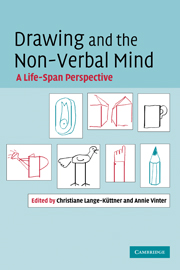Book contents
- Frontmatter
- Contents
- Contributors
- 1 Contemporary enquiries into a long-standing domain: Drawing research
- Part I Self, symbols and intention
- 2 Understanding reflections of self and other objects
- 3 Drawing production, drawing re-experience and drawing re-cognition
- 4 Style and other factors affecting children's recognition of their own drawings
- 5 Children's understanding of the dual nature of pictures
- 6 Pictorial intention, action and interpretation
- Part 2 Syntax, space systems and projection
- Part III Aging, blindness and autism
- Index
- References
2 - Understanding reflections of self and other objects
Published online by Cambridge University Press: 22 September 2009
- Frontmatter
- Contents
- Contributors
- 1 Contemporary enquiries into a long-standing domain: Drawing research
- Part I Self, symbols and intention
- 2 Understanding reflections of self and other objects
- 3 Drawing production, drawing re-experience and drawing re-cognition
- 4 Style and other factors affecting children's recognition of their own drawings
- 5 Children's understanding of the dual nature of pictures
- 6 Pictorial intention, action and interpretation
- Part 2 Syntax, space systems and projection
- Part III Aging, blindness and autism
- Index
- References
Summary
Bard explains how understanding reflections of reality via the mirror begins at about 2 years of age. Recognizing reflections of the self appears to follow a different developmental route than recognizing reflections of objects. Research on the development of mirror experience in infants and chimpanzees is reviewed, and some intriguing research using video techniques is described. The chapter provides insight into the general factors and specialized pathways involved in the onset of awareness of reflective reality.
this chapter reviews developmental and comparative studies of mirror self-recognition. In children and also in chimpanzees, self-awareness has been studied using the mark-and-mirror test (for overviews see Bard, Todd, Bernier, Love and Leavens, 2006; Courage, Edison and Howe, 2004). In this assessment, the objective target behaviour is the ability to touch a mark on one's own face, as a result of seeing the self-image reflected in the mirror. Mirror self-recognition (MSR) is often considered the point of origin for self-awareness because it appears to be the first time when the self is objectively identified. We take a comparative perspective, reviewing the literature on the development of MSR in human and chimpanzee infants, and in other primate species, and suggest that passing the mark test isn't about understanding the reflective properties of the mirror, isn't about discovery of the mark by looking at the mirror image, but is something special about being self-aware.
- Type
- Chapter
- Information
- Drawing and the Non-Verbal MindA Life-Span Perspective, pp. 23 - 41Publisher: Cambridge University PressPrint publication year: 2008
References
- 4
- Cited by



